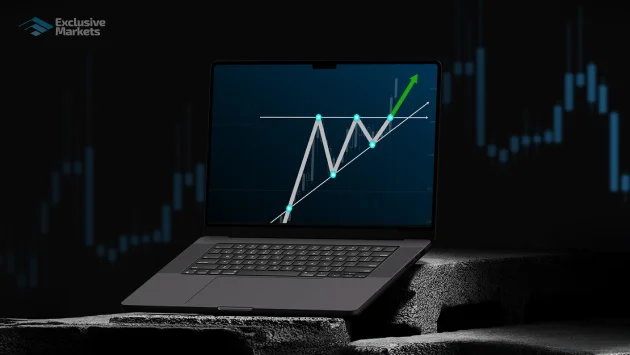
Table of Content
In the world of forex trading, technical analysis is a cornerstone strategy that helps traders make informed decisions. Among the many chart patterns that signal potential price movements, triangle patterns are some of the most reliable and widely recognised formations. Whether you’re a beginner or a seasoned trader, understanding how to identify and trade triangle patterns. This may help improve your trading accuracy when used with proper risk management and confirmation tools.
This comprehensive guide will walk you through everything you need to know about triangle chart patterns in forex, including their types, how to recognise them, what they indicate, and the best strategies to trade them effectively.
What Are Triangle Chart Patterns?
Triangle chart patterns are a form of consolidation that occurs when the price of a currency pair moves into a tighter range over time, creating a triangle-like shape on the chart. This compression of price movement reflects a battle between buyers and sellers, with neither side gaining full control.
Eventually, the price breaks out of the triangle, usually resulting in a significant price movement. The direction of the breakout (up or down) often determines the trading opportunity.
Types of Triangle Chart Patterns
There are three primary types of triangle patterns:
-
Symmetrical Triangle
This pattern is formed when both the upper and lower trendlines converge toward each other, with the price making lower highs and higher lows.
- Indicates indecision in the market.
- Can lead to a breakout in either direction.
- Volume usually declines as the pattern progresses.
-
Ascending Triangle
An ascending triangle has a flat resistance line (upper trendline) and a rising support line (lower trendline), showing that buyers are gradually gaining strength.
- Often considered a bullish continuation pattern.
- Suggests accumulation and increasing buying pressure.
-
Descending Triangle
This pattern features a flat support line and a declining resistance line, suggesting sellers are gradually pushing the price down.
- Typically, a bearish continuation pattern.
- Reflects increasing selling pressure.
Identifying Triangle Patterns in Forex
Traders identifying forex triangle patterns requires attention to the following elements:
- Trendlines: Use trendlines to connect the highs and lows of price movement. The shape of these lines will indicate the type of triangle.
- Number of Touch Points: Ideally, you want at least two touches on both the upper and lower trendlines to confirm the pattern’s formation.
- Volume: Volume usually decreases as the pattern progresses. A spike in volume at the breakout point often confirms the move.
- Time Frame: Triangle patterns can form on any time frame, but they tend to be more reliable on longer time frames like the 1-hour, 4-hour, or daily chart.
Key Stages of a Triangle Pattern
Triangle patterns typically follow a three-stage process:
- Formation
Price begins consolidating between converging trendlines. Traders observe the pattern and prepare for a potential breakout.
- Compression
The range of price movement narrows. Volume typically declines. This stage indicates indecision and builds tension for a breakout.
- Breakout
Price breaks above or below the triangle. This move is often accompanied by an increase in volume and momentum.
How to Trade Different Triangle Patterns?
There are different triangular patterns that provide valuable insight into market mood and likely breakout points. Having knowledge of how to trade triangle patterns efficiently can support your forex trading strategy with clearer structure, though outcomes will always depend on market conditions.
Ascending Triangle Patterns
Ascending triangles are typically bullish trends. The flat top resistance line indicates sellers are keeping the line intact, but the upward support trendline indicates buyers are taking control slowly. They can be traded in the following steps:
- Identify the pattern: Look for the flat resistance and increasing support trendline. Make sure there are a minimum of two points of contact on each line.
- Wait for a breakout: Don't anticipate the breakout. Wait for the price to break decisively above the resistance line.
- Confirm with volume: A strong breakout to the upside should be supported with rising volume, which means genuine buying interest.
- Enter the trade: Buy after the breakout candle closes above the resistance or potentially enter on a retest of the broken resistance-turned-support level.
- Set stop-loss: Set your stop-loss below the rising support line or the recent swing low.
- Set take-profit: Take the height of the triangle and extend it upwards from the breakout point to set your target.
Descending Triangle Patterns
Descending triangles are typically bearish continuation patterns. The flat lower support line suggests buyers are holding the price, while the declining resistance line indicates mounting selling pressure. Following are the steps to trade:
- Identify the pattern: Look for a flat support base and a descending resistance line, with at least two bounces on each side.
- Wait for a breakdown: Entry should only be considered once price breaks below the support level.
- Volume confirmation: As with other triangle patterns, watch for a volume spike during the breakdown to confirm the move.
- Enter the trade: Sell once the candle closes below support or enter on a pullback to the broken support acting as resistance.
- Set stop-loss: Place your stop-loss above the descending resistance line or the recent swing high.
- Set take-profit: Use the vertical height of the triangle to project a downside target from the breakout point.
By learning to trade all three triangle patterns, symmetrical, ascending, and descending, you can take advantage of a wide range of market setups. The key lies in patience, breakout confirmation, and disciplined risk management.
Symmetrical Triangle Patterns
Since symmetrical triangles are neutral patterns, trading them requires confirmation of breakout direction. Some of the trading steps you may follow are as below:
- Identify the pattern: Draw trendlines to confirm convergence.
- Wait for breakout: Avoid entering before a confirmed breakout.
- Confirm with volume: A strong breakout is often accompanied by a volume spike.
- Enter trade: Buy on upward breakout, sell on downward breakout.
- Set stop-loss: Place it just outside the opposite side of the triangle.
- Set target: Measure the widest part of the triangle and project that distance from the breakout point.
Entry and Exit Strategies
Entry Points
- Wait for a clear breakout candle beyond the triangle.
- Confirm with indicators like RSI, MACD, or volume.
- Consider entering on a retest of the broken level for better risk-reward.
Stop-Loss Placement
- For bullish trades: Place stop-loss below the last swing low or triangle support.
- For bearish trades: Place stop-loss above the last swing high or triangle resistance.
Take-Profit Levels
- Use the triangle height to project targets.
- Consider multiple targets for scaling out.
- Trail stop-losses to lock in profits.
Using Indicators with Triangle Patterns
Indicators can help confirm the strength of triangle breakouts:
- RSI (Relative Strength Index)
- Use RSI divergence to predict breakout direction.
- An overbought or oversold signal near a breakout can provide added confidence.
- MACD (Moving Average Convergence Divergence)
- MACD crossover or histogram expansion can confirm momentum.
- Aligns well with breakout candles.
- Volume
- A sharp increase in volume confirms a strong breakout.
- Low volume breakouts may indicate a false move.
Common Mistakes to Avoid
- Trading Without Confirmation: Jumping into trades before a confirmed breakout leads to false entries.
- Ignoring Volume: Volume helps verify breakouts. Ignoring it can increase false signals.
- Forcing Patterns: Seeing triangles where they don’t exist can lead to poor decisions. Wait for clear structure.
- Poor Risk Management: Always use stop-losses and manage position size properly.
- Trading Against the Trend: In continuation setups, trading against the prior trend is risky unless there are strong reversal signals.
Common Mistakes to Avoid
- Use Multiple Time Frame Analysis: Check triangle patterns across higher time frames for validation.
- Combine with Trendlines and Fibonacci: Fibonacci retracements or extensions can align with breakout levels.
- Look for Confluence: When triangle patterns align with support/resistance zones or moving averages, they become stronger.
- Practice Patience: Wait for clean breakouts and avoid early entries.
- Journal Your Trades: Tracking your triangle pattern trades can help refine your strategy.
Conclusion
Triangle chart formations are practical tools in the arsenal of a forex trader. They provide orderly, graphical representations of market consolidation and potential breakouts. Traders can take advantage of key price movements by knowing the features of symmetrical, rising, and falling triangles, and by strategizing entries and exits.
Success in trading triangle patterns depends not only on recognising them, but also on waiting for validation, risk management, and employing accompanying aids such as volume and indicators.
With discipline and practice, triangle patterns can be a valuable component of your trading strategy when applied with care and discipline. This enables you to navigate the market with greater structure and awareness of both opportunities and risks.
Are you Ready to Explore the World of Trading?
Disclaimer: The information provided on this blog is for educational/informational purposes only and should not be considered financial/investment advice. Trading carries a high level of risk, and you should only trade with capital you can afford to lose. Past performance is not indicative of future results. We do not guarantee the accuracy or completeness of the information presented, and we disclaim all liability for any losses incurred from reliance on this content.

 744
744 08-10-2025
08-10-2025